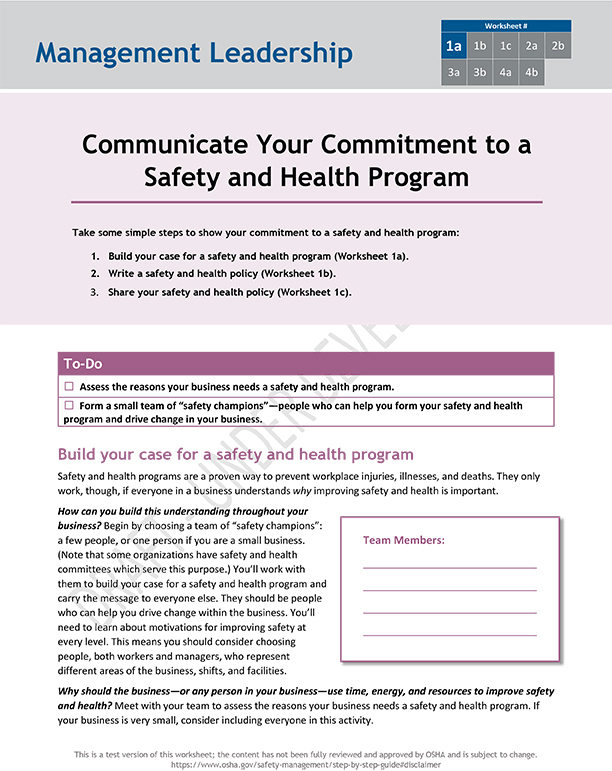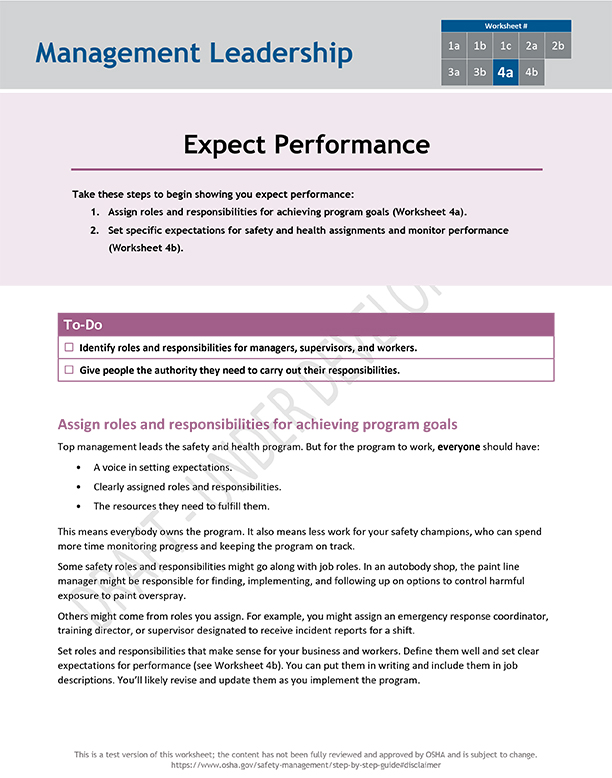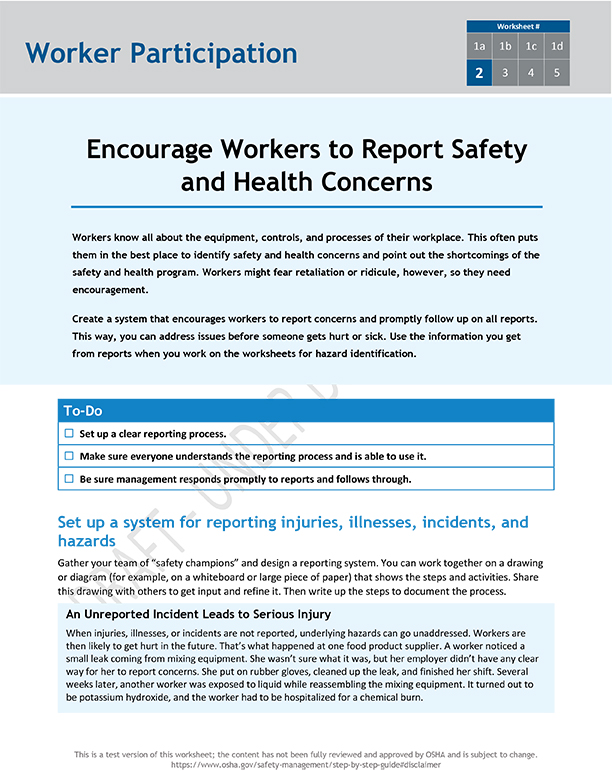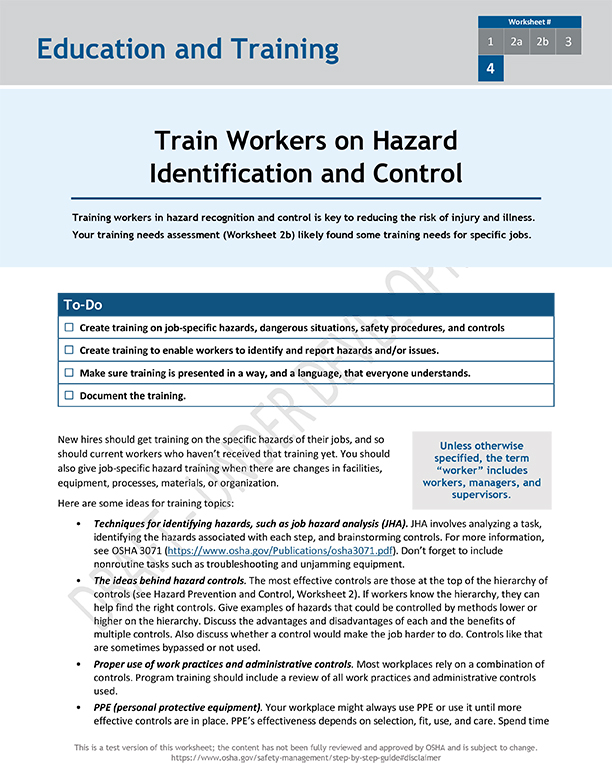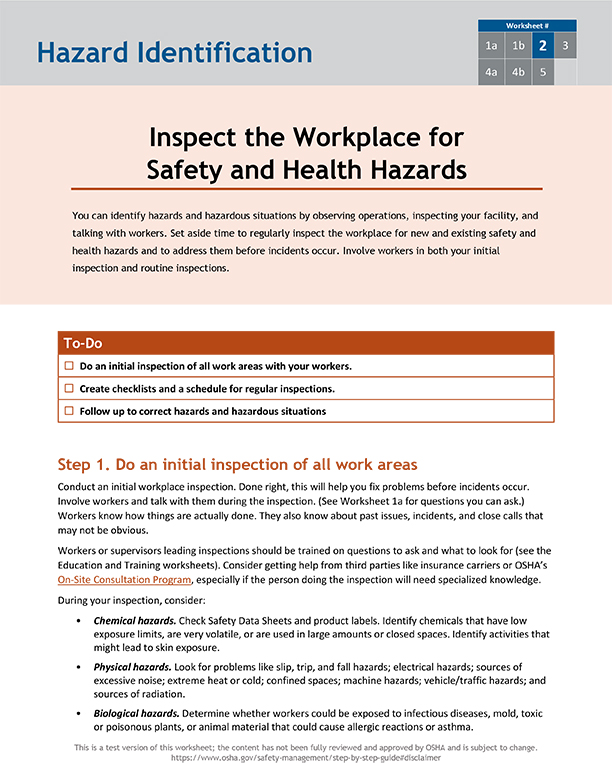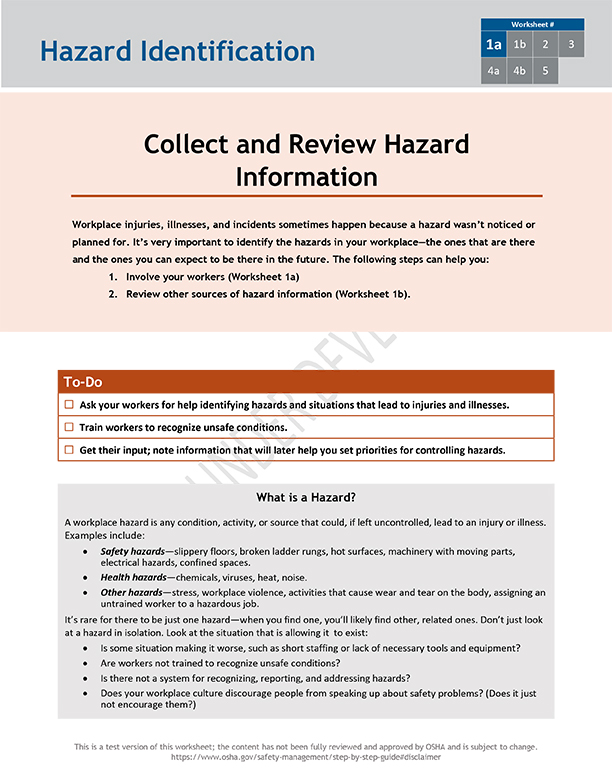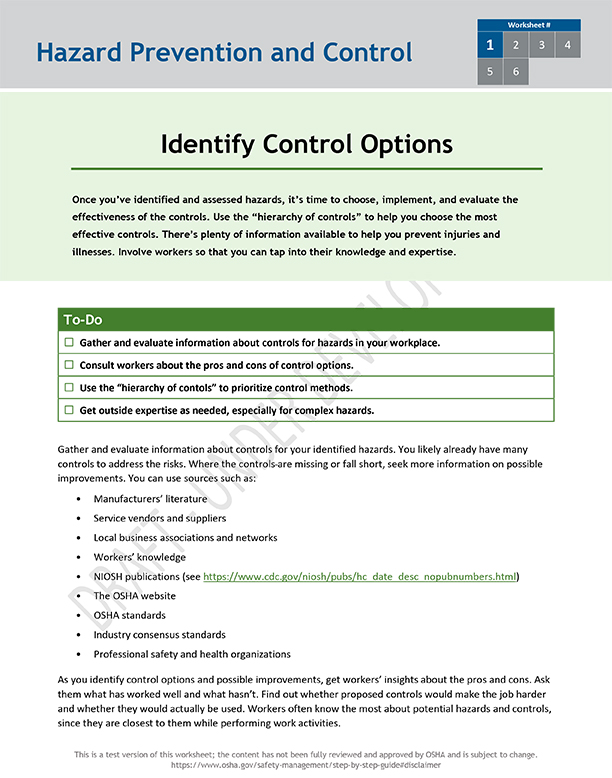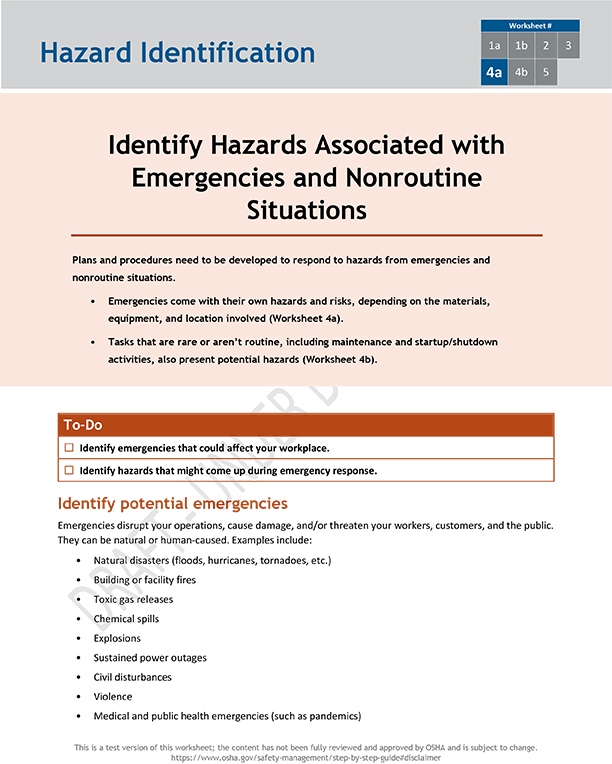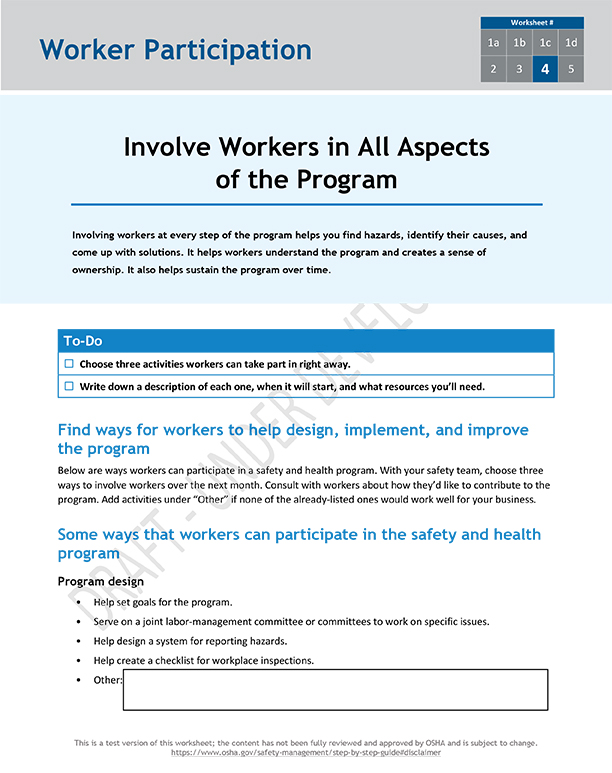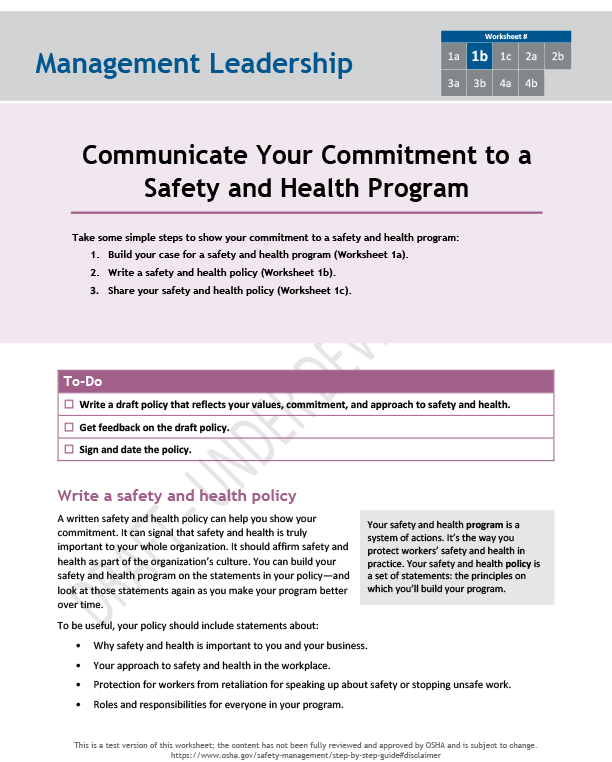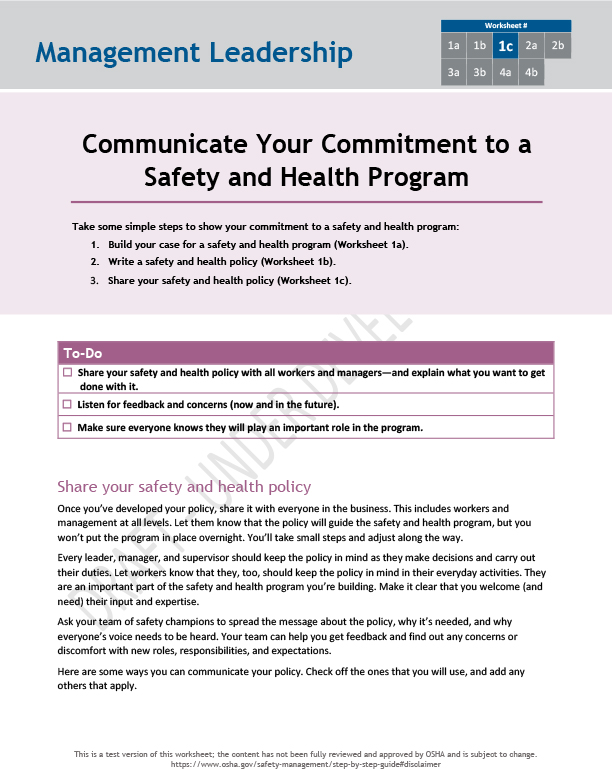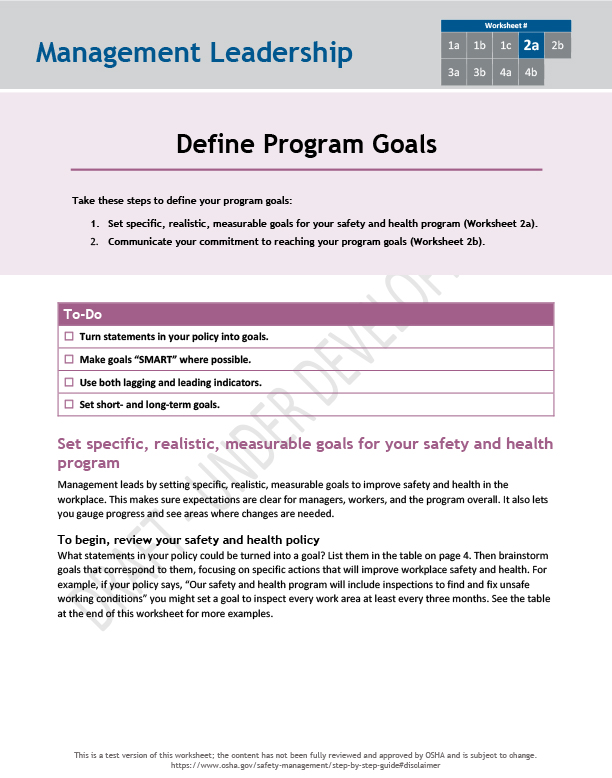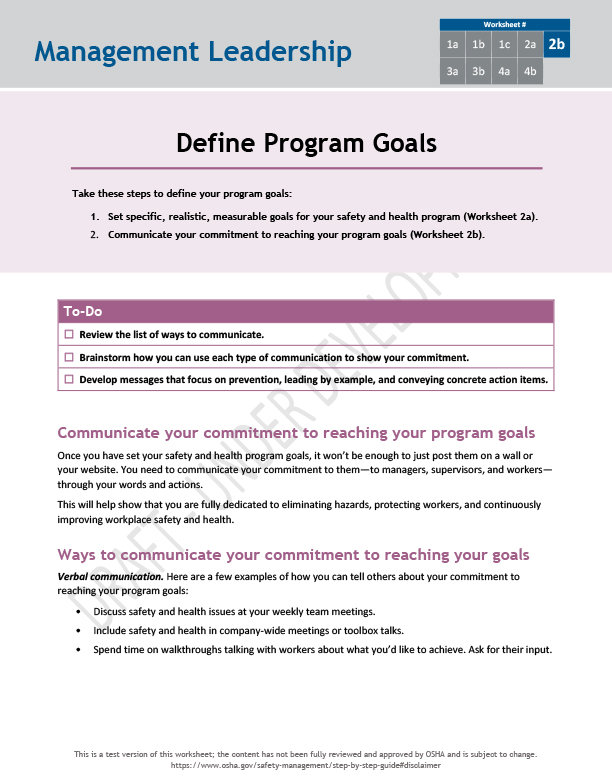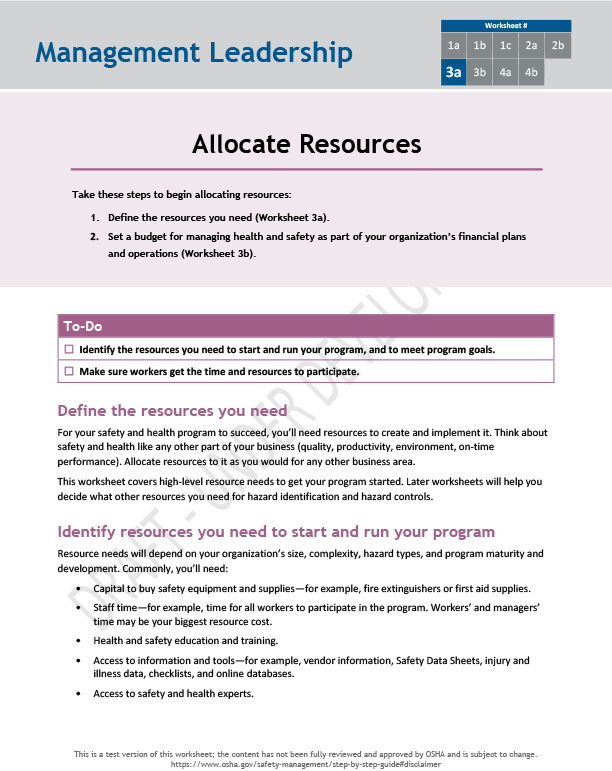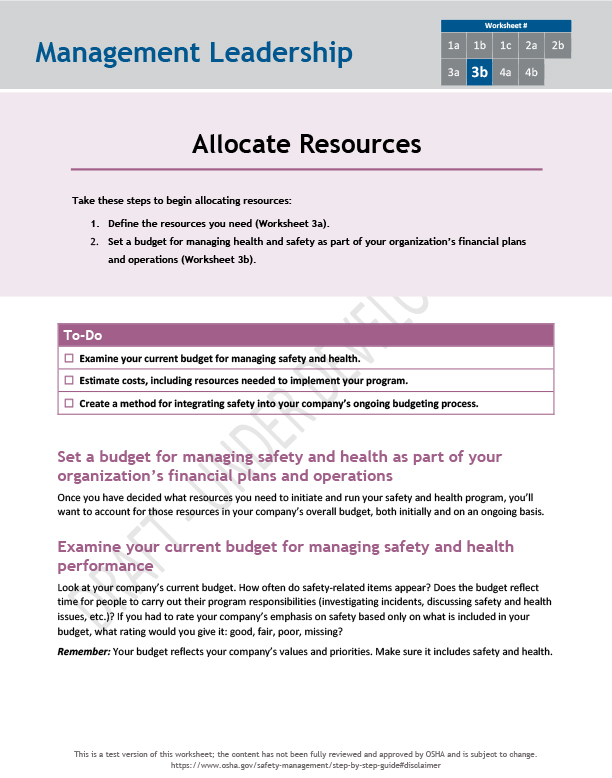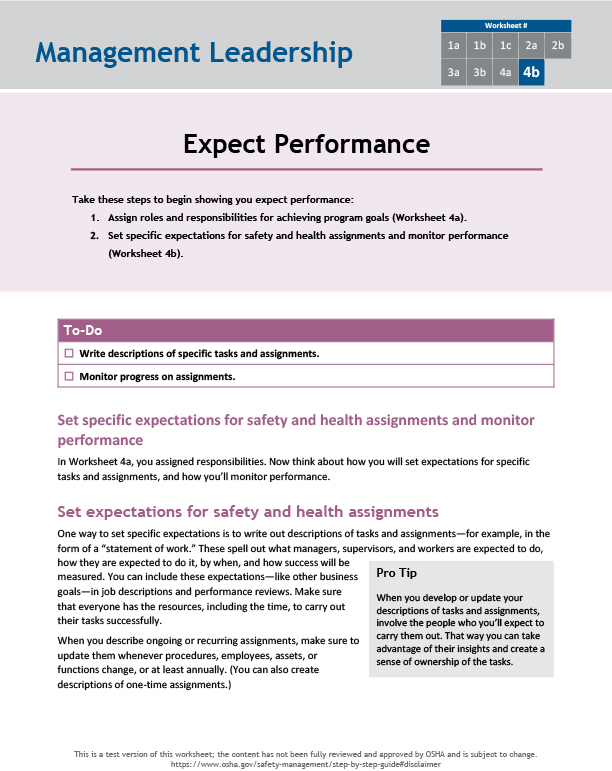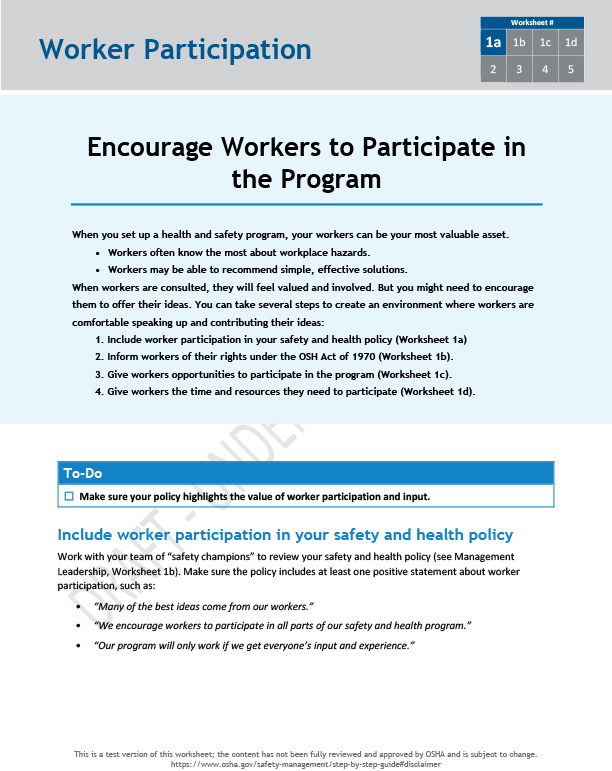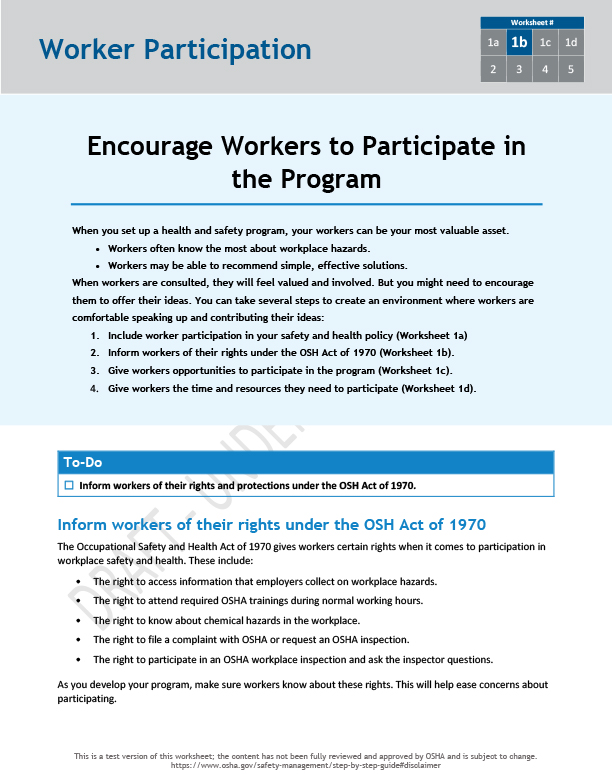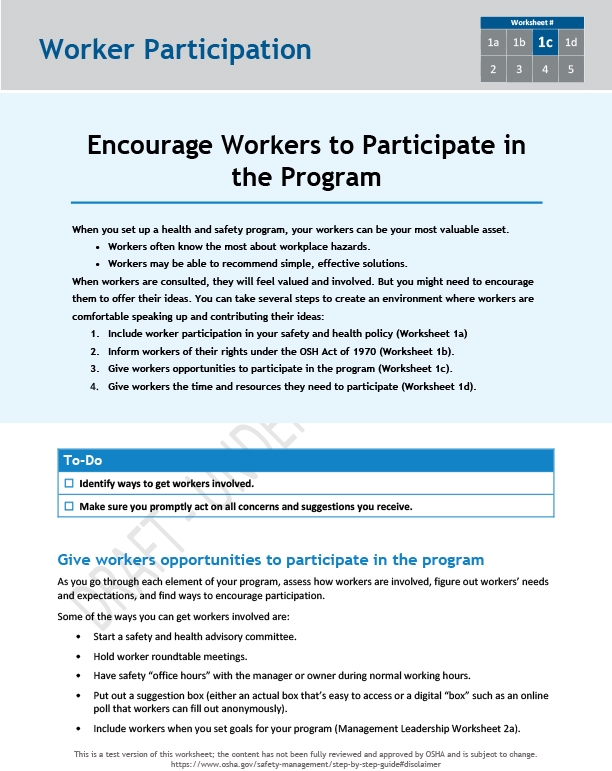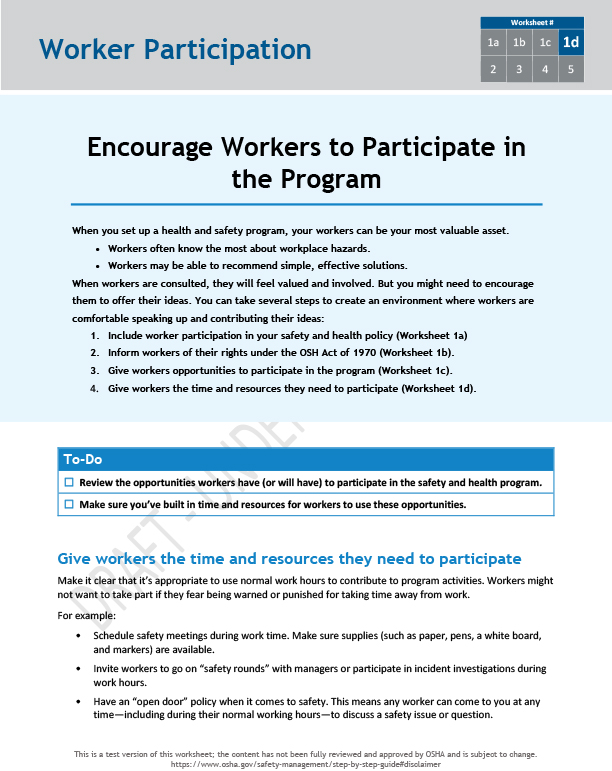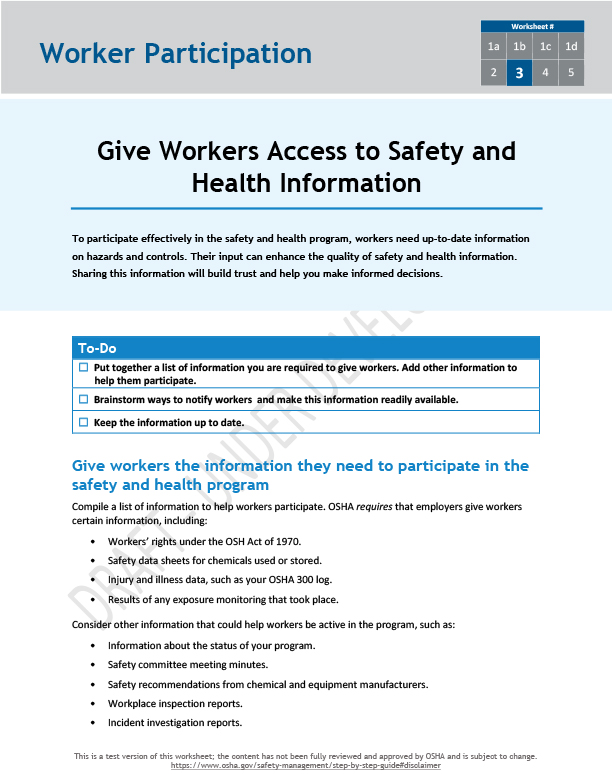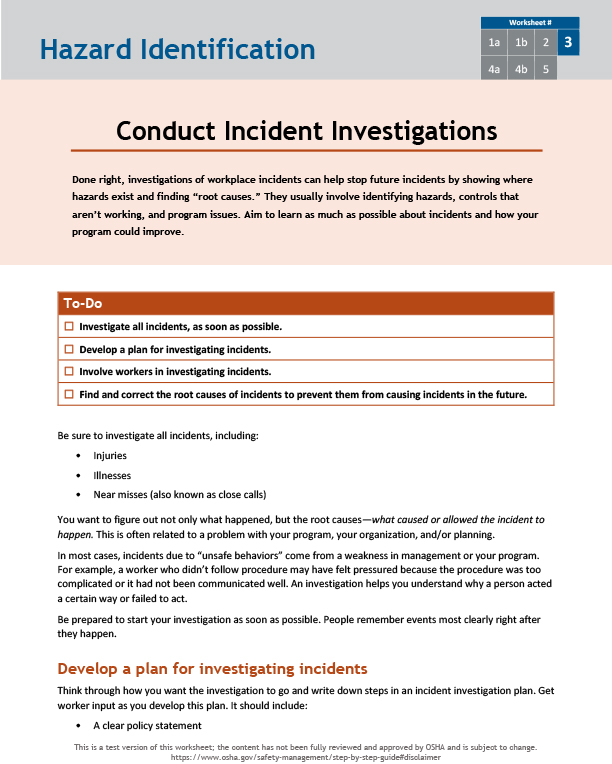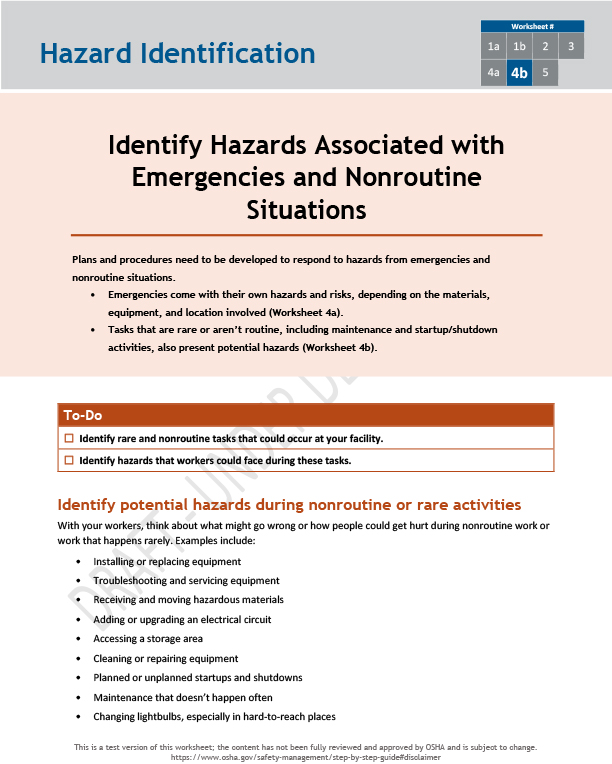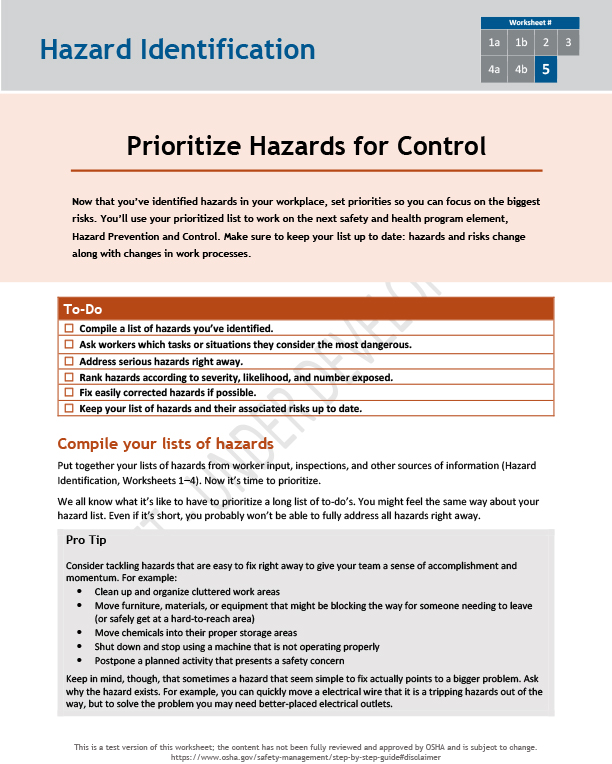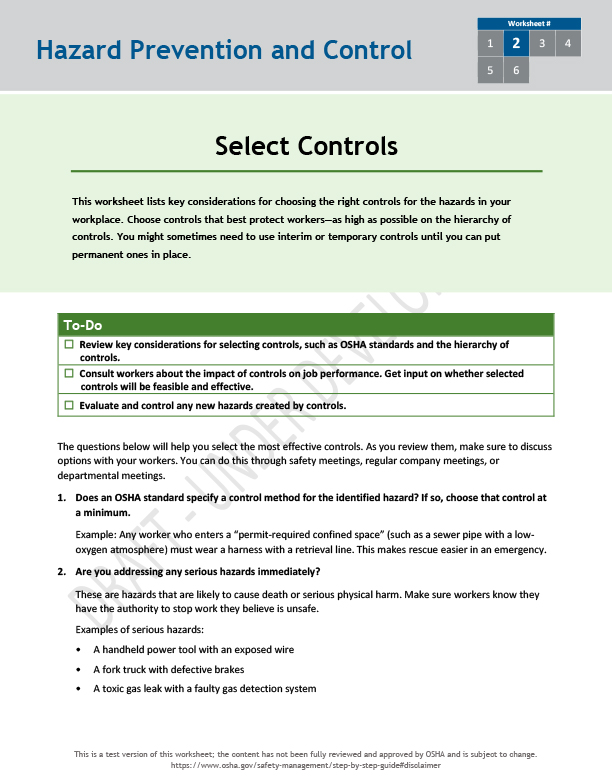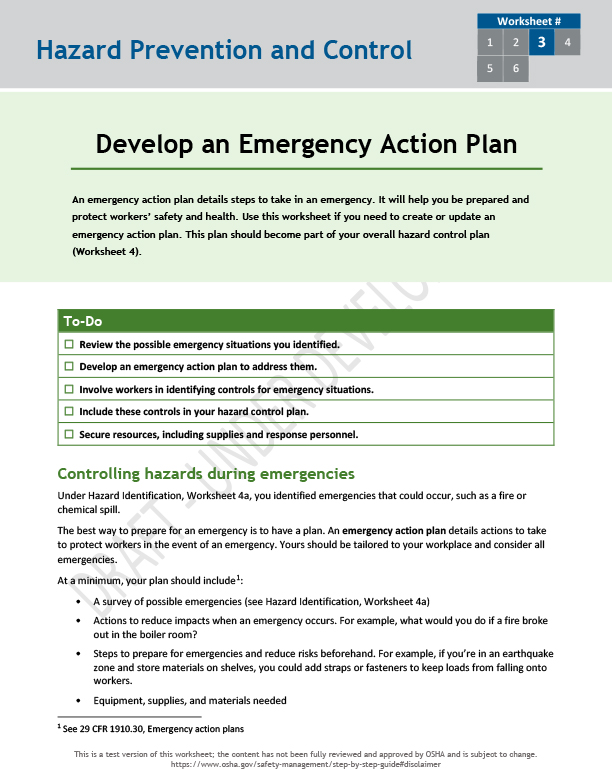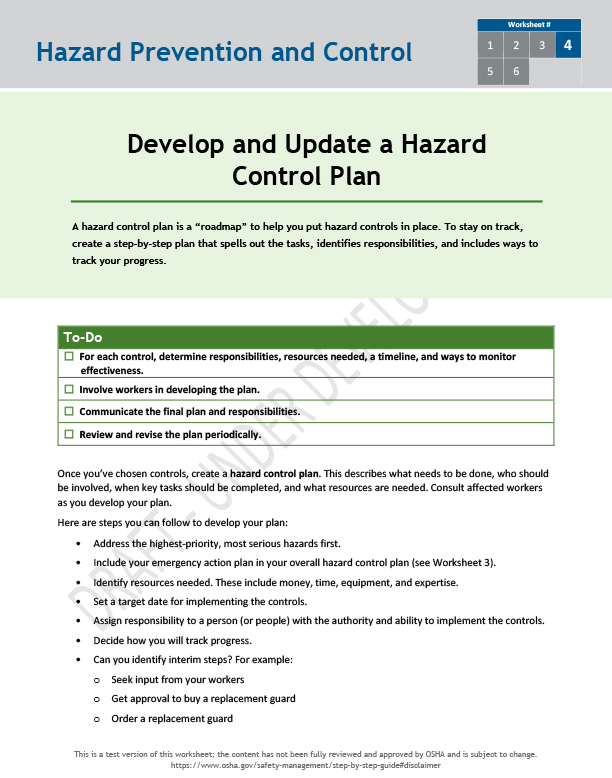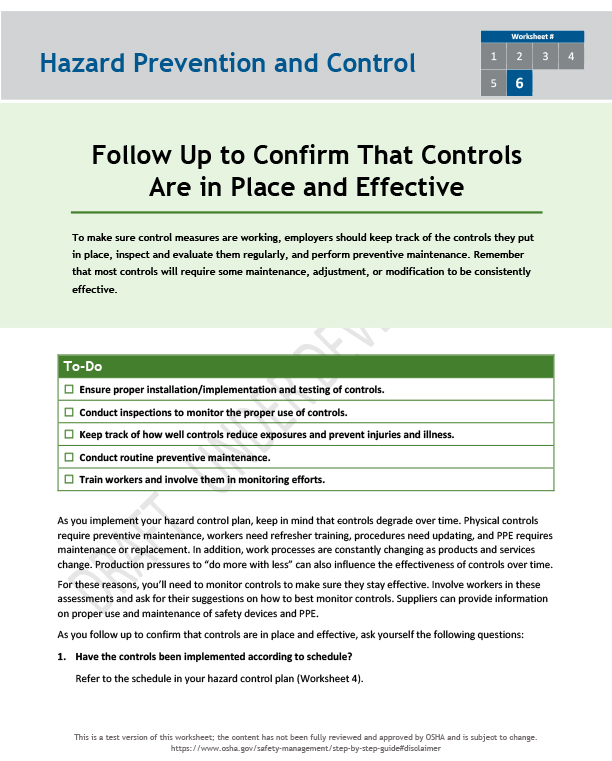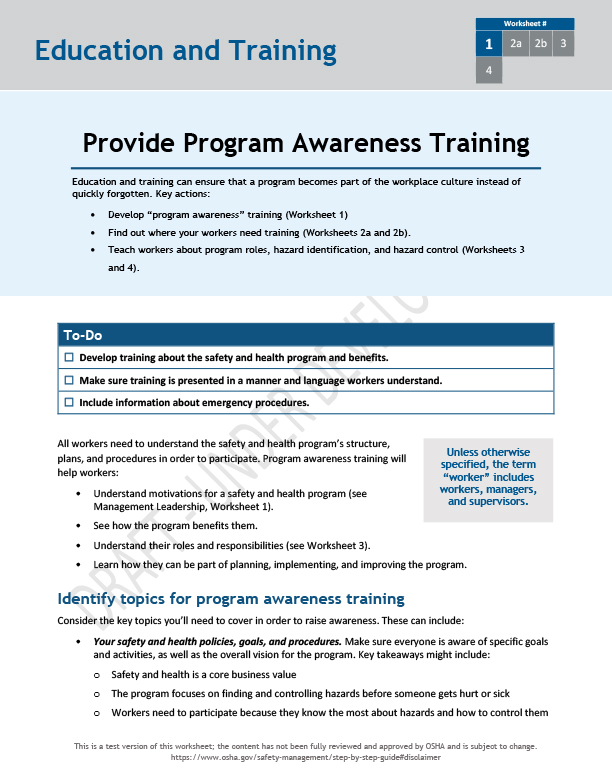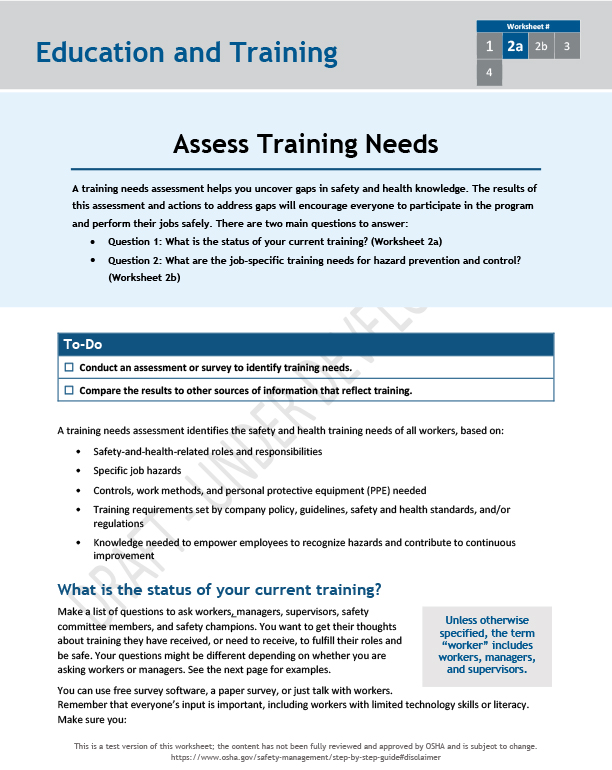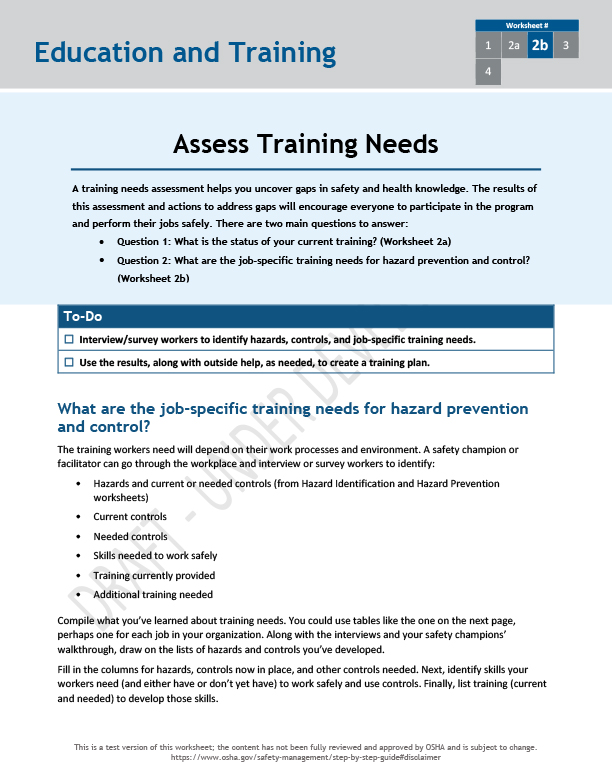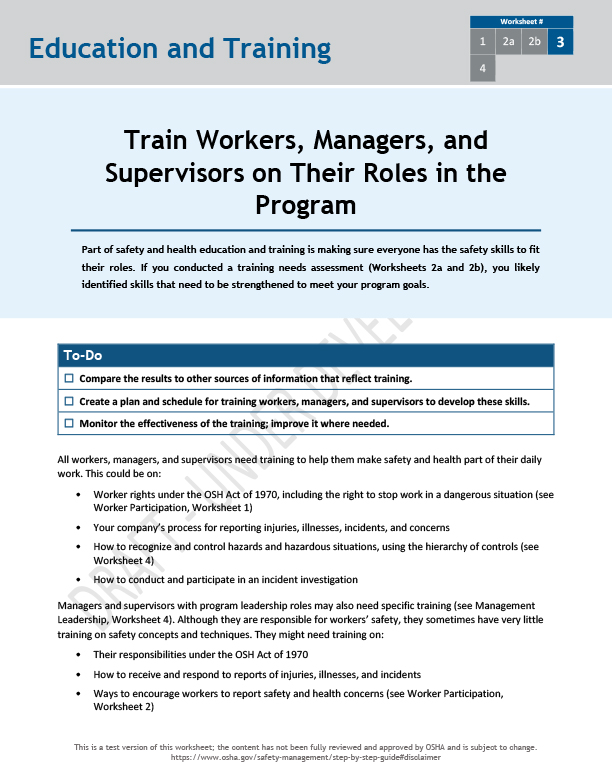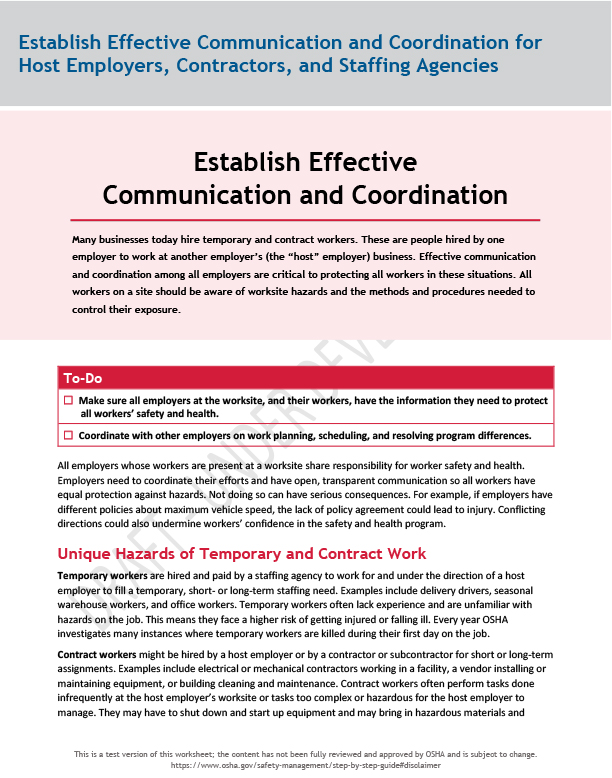Level 1 - Getting Started
The Safety and Health Programs Step-by-Step Guide is under development. The primary purpose of this field test is to obtain feedback on usefulness and how the worksheets can be improved. The content has not been fully reviewed or approved by OSHA and is subject to change.
[Full Disclaimer]
Level one will help you start to implement a safety and health program and includes activities and action steps to help employers tailor the content and advance their safety and health program. These steps will give you the foundation from which to take on some of the more structured actions you may want to include in your program.
If you find that the foundational core elements of your SHP are in place and operating, go to level 2 for information about growing and fine tuning the SHP.
Option 1: Explore by Step
Follow these 10 steps to get your program started:
Option 2: Explore by Core Element
Scroll through the core element galleries below to find corresponding worksheets that can help you implement, assess, and improve your safety and health program. Not sure which element to start with? Users may find the following resource helpful when deciding.
Download the "Starting Your Journey" resource.
Management Leadership
Building Your Case for a Safety and Health Program
Build your case for a safety and health program:
- Assess the reasons your business needs a safety and health program.
- Choose a team of safety champions to help form your program and drive change.
Write a Safety and Health Policy
Write a safety and health policy for your workplace:
- Draft a policy that reflects your values.
- Get feedback on the draft policy.
- Revise and sign the policy.
Share Your Safety and Health Policy
Spread the message about your safety and health policy:
- Share your policy with everyone in your company:
- Listen for feedback and concerns.
- Ensure that everyone understands their role in the program.
Define Program Goals
Turn policy statements into goals for your safety and health program:
- Set specific, realistic, measurable goals for your program.
- Use both lagging and leading indicators.
- Set both short-term and long-term goals.
Commit to Achieve Program Goals
Communicate your commitment to reaching your program goals:
- Brainstorm a variety of ways to communicate your program goals.
- Develop messages that focus on prevention, leading by example, and concrete actions.
Defining Resources Needed
Define the resources you need to start, run, and meet the goals of your safety and health program:
- Identify resources needed to achieve program goals.
- Make sure you allocate adequate resources for workers to participate fully.
Allocate Resources
Set a budget for managing safety and health as part of your financial plan and operations:
- Examine your current budget for managing safety and health.
- Estimate costs of resources you identified.
- Integrate safety into your ongoing budgeting process.
- Fund your program, including hazard assessment/control activities.
Assign Roles and Responsibilities
Assign roles and responsibilities to achieve program goals:
- Assign roles and responsibilities for managers, supervisors, and workers.
- Make sure people have the authority they need to fulfill their roles.
Expect Performance
Set specific expectations for safety and health assignments and monitor performance:
- Set specific expectations for safety and health assignments.
- Monitor performance to help evaluate and improve the program.
Worker Participation
Worker Participation in Your Safety And Health Program
Understand why worker participation is key to a successful program:
- Work with your safety champions to review the current safety and health policy.
- Make sure the policy includes statements that highlight the value of worker participation.
Workers' Rights
Inform workers of their rights:
- Understand workers' rights and prohibition against retaliation.
- Brainstorm how and when you will inform workers of their rights.
Opportunities to Participate in Your Program
Get workers involved in your safety and health program:
- Identify ways to get workers involved.
- Set up a process to follow through quickly on concerns and suggestions.
- Brainstorm new ways to encourage worker participation in your safety and health program.
Time and Resources to Participate
Give workers the time and resources needed to participate in your safety and health program:
- Review opportunities for worker participation.
- Build in time and resources so workers can use these opportunities.
- Complete an activity to determine how to provide time and resources for worker participation.
Reporting Safety and Health Concerns
Encourage workers to report safety and health concerns:
- Set up a reporting process.
- Ensure everybody understands the reporting process.
- Ensure management responds promptly to worker safety concerns.
- Complete a training activity that helps you design a reporting system.
Access to Safety and Health Information
Give workers access to up-to-date information on safety hazards and controls:
- Prepare a list of information you are required to give workers.
- Brainstorm ways to make this information readily available.
- Keep the information up to date.
Hazard Identification and Assessment
Review Hazard Information from Workers
Involve the workers in identifying hazards in the workplace:
- Understand the definition of a workplace hazard.
- Involve workers in the process of identifying workplace hazards.
- Start a conversation with workers about hazards on the job and setting priorities for hazard control.
Review Hazards from Other Sources
Review other sources of hazard identification:
- Find and review sources of information to help identify hazards.
- Include all worksites, areas, and tasks when identifying hazards.
- Review relevant safety and health information before making changes in the workplace.
Inspect the Workplace for Hazards
Identify hazards and hazardous situations:
- With workers, do an initial inspection of work areas with workers.
- Set up routine inspections.
- Follow up to correct hazards.
Conduct Incident Investigations
Investigate injuries, illnesses, and near misses:
- With worker involvement, investigate all incidents as soon as possible.
- Develop a plan for investigating incidents.
- Find and correct the root causes of incidents to prevent future incidents.
Identify Potential Emergencies
Develop plans and procedures to prevent and respond to emergencies:
- Identify potential emergencies.
- Identify hazards that might come up during emergency response.
- Use the results to set priorities for control.
Identify Nonroutine Activities
Address hazards during nonroutine situations:
- Identify nonroutine or rare activities in the workplace.
- Brainstorm hazards that workers could face during these tasks.
- Use the results to set priorities for control.
Prioritize Hazards For Control
Prioritize hazards identified to focus on the biggest risks:
- Compile your list of hazards.
- Ask workers which they consider most dangerous.
- Assess the risks and prioritize.
- Keep the list up to date.
Hazard Prevention and Control
Identify Control Options
Identify and evaluate controls for hazards in your workplace:
- Gather information about controls.
- Use the hierarchy of controls to prioritize control methods.
- Consult with workers and outside experts.
- Complete an activity to identify new or better hazard controls.
Select Controls
Select effective controls for workplace hazards:
- Review key considerations for selecting controls.
- Consult with workers on impacts of new controls.
- Address new hazards created by controls.
- Complete an activity that helps your team choose a control for each workplace hazard.
Develop An Emergency Action Plan
Develop your Emergency Action Plan:
- Review the possible emergency situations.
- With worker input, develop an emergency action plan to address each situation.
- Secure resources to implement the plan.
- Complete an activity that helps you write your Emergency Action Plan.
Develop and Update A Hazard Control Plan
Update your hazard control plan:
- With worker input, determine how to implement each hazard control.
- Publicize and distribute the final hazard control plan.
- Review and revise the plan as needed.
- Complete an activity that helps you plan, track, and update the hazard control plan.
Implement Selected Hazard Controls
Implement workplace hazard controls:
- Identify manageable steps to start implementing the hazard control plan.
- Anticipate potential obstacles.
- Monitor progress and adjust.
- Complete an activity to anticipate and overcome obstacles to implementation.
Follow Up On Effectiveness
Ensure the effectiveness of workplace hazard controls:
- Ensure proper installation, monitoring, and maintenance of hazard controls.
- With worker involvement, conduct inspections and track the effectiveness of controls.
- Conduct routine preventive maintenance.
- Complete an activity to evaluate the effectiveness of a hazard control.
Education and Training
Program Awareness
Build successful program awareness training:
- Identify the key topics for program awareness training.
- Make sure all workers can understand and participate in the training.
- Develop training on emergency procedures.
- Complete an activity to design three short training activities related to the program's structure, goals, or procedures.
Assess Current Training Needs
Address gaps in your training program:
- Conduct a survey or assessment of the current status of training.
- Use the survey results and other sources of information to identify gaps in your training program.
Assess Job Specific Training Needs
Identify the job-specific training needs for your program:
- Interview workers to identify hazards, controls, and job-specific training needs.
- Use results and any outside help needed to create a training plan.
Understanding Program Roles
Train workers, managers, and supervisors on their program roles:
- Create a plan to conduct training on skills needed to fulfill program roles.
- Monitor the effectiveness of this training.
- Track training by topic.
- Complete an activity to plan short trainings sessions to be delivered over four to six months.
Hazard Prevention and Controls Training
Train workers in hazard recognition and control to reduce the risk of injury and illness:
- Create job-specific training.
- Train workers on how to identify and report hazards.
- Make sure everyone can understand the training.
- Document the training.
Program Evaluation and Improvement
Monitor Performance
Determine the performance and progress of your safety and health program:
- Select and train your evaluation team.
- Track progress toward your targets and goals.
- Develop a step-by-step process for monitoring program performance and progress.
Verify Program Operation
Ensure your program is working as intended and get closer to your safety and health goals:
- Review the implementation of core program elements.
- Develop questions to evaluate if your safety and health plan is in place and working.
- Document and communicate your findings.
Correct and Improve Your Program
Work with supervisors, managers, and workers to correct program shortcomings:
- Seek input on how to improve your safety and health program.
- Promptly correct problems in your program.
- Update the program as the workplace changes.
- Change goals and indicators as needed.
Communication and Coordination for Host Employers, Contractors, and Staffing Agencies
Communication and Coordination
Establish effective communication and coordination among host employers, contractors, and staffing agencies:
- Understand the unique hazards of temporary and contract work.
- Plan for open, transparent communication and coordination.
- Complete an activity to brainstorm the communication and coordination needs of your business.


